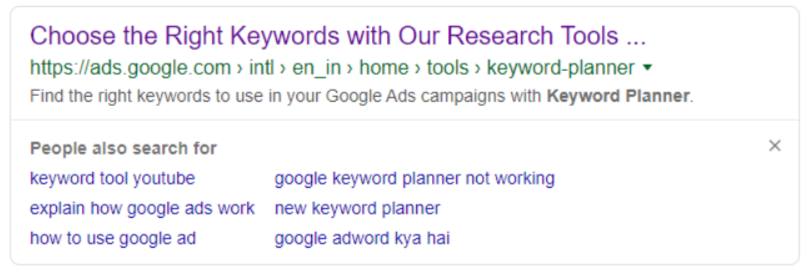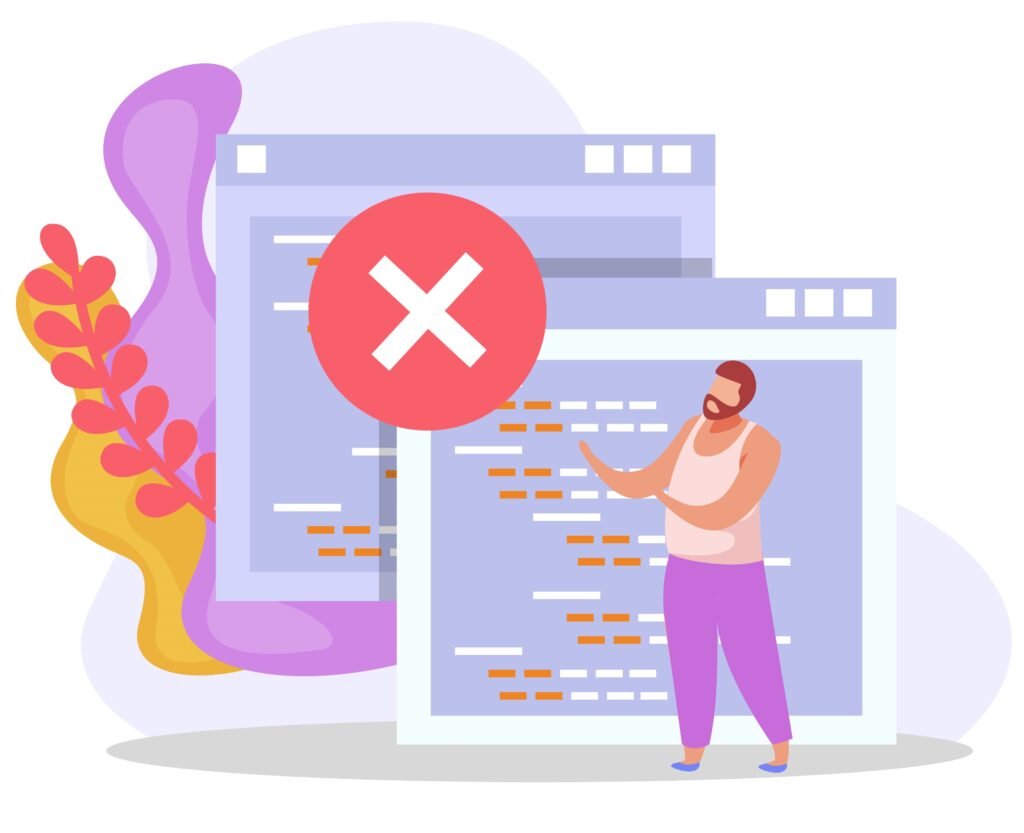
In today’s world of digital marketing, search engine optimization (SEO) has become increasingly important. Regarding SEO, one of the most powerful tools available is the “People also search for” feature. This feature can provide valuable insights into user behavior and help you identify related topics and keywords to improve your search engine results.
So, to understand it better, we have created this blog, which aims to provide a comprehensive understanding of what “People also search for” is, why it’s important, how to use it, and the best practices for incorporating it into your SEO strategy.
So, let’s get started.
What Is “People Also Search For”?
The “People also search for” feature is a list of related searches that appear below the main search results. These associated searches are generated depending on the keywords used in your search query.

The list includes different variations and similar queries other users have searched for about your original query. This feature helps users to refine their search and find the information they need more efficiently.
How Are “People Also Search For” Generated?

The “People also search for” feature is generated through a sophisticated process involving complex algorithms and machine learning techniques employed by search engines.
When a user submits a query, the search engine goes beyond a simple keyword match and delves into comprehending the underlying intent of the user. It then uses this understanding to create a list of related searches that may interest the user.
Several factors contribute to the generation of these suggestions:
- Keyword Analysis: The search engine examines the original search query and identifies relevant keywords and phrases commonly associated with it. This helps in finding related topics and queries.
- User Behavior: Valuable data on user behavior is analyzed. This includes which related searches are frequently clicked on or which results receive more prolonged user engagement. The search engine can offer more relevant and appealing suggestions by considering user preferences.
- Historical Data: The search engine draws insights from historical search data, analyzing patterns and trends in previous searches. This historical context assists in making informed connections between queries and generating meaningful suggestions.
- Analysis of Content: The content present on web pages is scrutinized to identify underlying themes, topics, and concepts. The search engine can accurately link related searches by understanding the content contextually.
- Machine Learning: Many search engines employ sophisticated machine learning algorithms to refine and improve their “People continuously also search for” suggestions. Over time, these algorithms learn from user interactions and adjust the suggestions to align better with user preferences and intent.
By combining these factors, search engines can generate relevant and valuable “People also search for” suggestions, enhancing the overall user experience and aiding digital marketers in optimizing their SEO strategies.
Why Is “People Also Search For” Important?
This is essential because it can improve SEO, increase website traffic, and provide insights into user behavior.
Improving SEO

To enhance your website’s SEO, leveraging the “People also search for” feature can be highly beneficial. This feature provides valuable insights into related searches relevant to the original query. Incorporating these keywords and topics into your content and website can improve your website’s relevance and authority for those specific terms, positively impacting your SEO results on search engine results pages (SERPs).
Let’s use an example to illustrate this further:
Suppose your website focuses on home renovation, and a user searches for “bathroom remodel.” The search engine’s “People also search for” feature might present related searches such as “bathroom renovation ideas,” “bathroom remodel cost,” or “small bathroom remodel.”
By strategically integrating these related searches into your website’s content, you achieve several SEO benefits:
- Improved Relevance: By including content that addresses related searches, your website becomes more relevant to users seeking information on various aspects of bathroom remodeling. Search engines recognize this relevance and are more likely to display your site in response to related queries.
- Enhanced Authority: As your website covers a broader range of related topics, it establishes itself as an authoritative resource in home renovation and bathroom remodeling. Search engines value traditional websites and tend to rank them higher in SERPs.
- Keyword Optimization: By incorporating these related search terms, you optimize your website for diverse keywords, expanding the chances of attracting organic traffic from multiple search queries.
- User Engagement: Addressing related topics provides users with a comprehensive and informative experience. Consequently, this can result in a higher duration of Time invested on your website and reduced bounce rates, both favorable indicators to search engines regarding the quality and relevance of your content.
- Long-Tail Keywords: “People also search for” suggestions often. Incorporate long-tail keywords that are more precise and focused. Integrating these long-tail keywords into your content allows you to capture niche audiences searching for specific information related to bathroom remodeling.
Increasing Website Traffic

Leveraging the “People also search for” feature to identify related searches and topics presents an excellent opportunity to increase website traffic. Creating valuable and relevant content based on these suggestions can attract more users actively searching for information on those specific topics to your website.
Let’s delve into a more detailed explanation:
- User Intent Alignment: When a user searches for a topic like “best beaches in Hawaii,” the “People also search for” feature provides insights into related queries that users commonly explore. By incorporating these related searches, such as “things to do in Hawaii,” “best time to visit Hawaii,” or “Hawaii vacation packages,” your content aligns with the intent of users seeking comprehensive information about Hawaii travel.
- Broadening Content Coverage: Addressing various related topics makes your website a comprehensive resource for users interested in Hawaii travel. This expansion of content coverage appeals to a broader audience, increasing the likelihood of attracting more organic traffic from diverse search queries.
- SEO Benefits: Creating valuable content around related searches optimizes your website. As search engines acknowledge the pertinence of your content to various associated queries, they are more likely to rank your website higher.
- Reflecting on the search results, this heightened visibility attracts organic traffic to your website.
- Long-Term Traffic Growth: The content you create based on “People also search for” suggestions remains relevant over time. As users continually search for information on these related topics, your website maintains steady traffic, contributing to long-term growth.
- User Engagement and Retention: Addressing related searches provides users with a satisfying experience on your website. They are more likely to spend time exploring various relevant topics, reducing bounce rates and increasing the likelihood of revisiting your site.
- Opportunity for Internal Linking: Creating content around related searches allows for internal linking within your website. When users discover relevant and interconnected content on your site, they are encouraged to explore further, leading to increased page views and improved session durations.
Understanding User Behavior

The “People also search for” feature provides valuable insights into user behavior and search intent. By understanding what users search for and the related queries they explore, you can create more relevant and engaging content while improving the overall user experience on your website.
Let’s dive deeper into the explanation:
- User Intent Identification: When a user searches for a specific topic, such as “workouts for beginners,” the “People also search for” feature presents related searches that users commonly explore. By analyzing these related searches like “best exercises for weight loss,” “fitness tips for beginners,” or “how to get started with exercise,” you gain valuable insights into the intent behind the original query. This comprehension empowers you to generate content that addresses your target audience’s distinct needs and interests.
- Relevant and Helpful Content: Armed with the knowledge that users searching for “workouts for beginners” are likely beginners, you can tailor your content to provide relevant and helpful information specifically designed for that audience segment. This may include beginner-friendly exercises, tips for starting a fitness journey, or guidance on proper form and technique. By meeting users’ needs, you enhance their experience On your website, raising the probability of user engagement, return visits, and positive feedback.
- Targeted Audience Engagement: By aligning your content with users’ search intent, you attract a more targeted audience to your website. These users seek information about their specific needs or interests, making them Likelier to interact with your content, share it with others, and become long-term visitors or customers.
- Improved User Experience: Understanding user behavior and intent allows you to optimize your website’s structure, navigation, and content organization to provide a seamless user experience. By anticipating the related topics and queries users are interested in, you can create logical pathways for exploration and ensure that Users can readily locate the information they require, enhancing their satisfaction.
- Opportunity for Expansion: The insights gained from the “People also search for” feature can inspire you to create additional content that addresses related queries and topics. This expands your website’s coverage and provides a more comprehensive resource for users. It also allows internal linking and cross-referencing within your content, allowing users to discover and explore relevant information more effectively.
Now that we have discussed the significance of the “People also search for” feature, let’s explore the tools available to leverage this valuable aspect of search engine optimization.
Tools For “People Also Search For”
Several tools can help you with “People also search for” research. Here are four of the most popular:
Google Search
It is a powerful tool for finding “People also search for” suggestions. Simply enter your search query into Google and Scroll down to the bottom of the search results page to find a compilation of related searches.
Google Trends

It is a free tool that allows you to see how search interest for a particular topic has changed over time. You can also see related issues and queries that are rising in popularity. This can be a helpful way to identify new and emerging trends that you can use to create content.
Ahrefs

Ahrefs is a tool for which payment is required, offering comprehensive SEO analysis, including “People also search for” suggestions.
Ahrefs can help you identify related topics and keywords available for content creation and provide insights into your competitors’ strategies.
SEMrush

It is another paid tool that analyzes SEO, including “People also search for” suggestions. SEMrush can help you identify popular search queries and topics and provide insights into your competitors’ strategies.
Common Mistakes And Pitfalls To Avoid

Overusing Unrelated Or Irrelevant “People Also Search For” Suggestions:
- Keyword Stuffing: Cramming unrelated keywords into content to match “People Also Search For” suggestions can lead to poor-quality and spammy content, negatively impacting user experience and SEO.
- Lack of Relevance: Including unrelated topics or keywords from “People Also Search For” can confuse users and decrease their trust in your website’s authority on the subject matter.
- Disruption of Content Flow: Overuse of unrelated suggestions can interrupt the coherence of your content, rendering it less coherent and more accessible for users to follow.
Neglecting User Intent And Creating Content Solely For SEO Purposes

- Sacrificing Quality for SEO: Focusing solely on SEO may lead to content that needs more substance and value for users, leading to high bounce rates and lower engagement.
- Ignoring User Need: Neglecting user intent means failing to address their specific questions or concerns, which can drive potential visitors away.
- Short-Term Gains vs. Long-Term Value: Prioritizing SEO over user intent may lead to short-term boosts in traffic but hinder your website’s ability to build lasting relationships and retain loyal visitors.
Ignoring The Importance Of Regular Updates And Optimization

- Outdated Content: Please update content based on changing user behavior and trends to make your website more relevant and valuable.
- Missed Opportunities: Ignoring the “People Also Search For” feature for extended periods means missing out on valuable insights and potential content ideas that could attract more traffic.
- Falling Behind Competitors: Websites that regularly optimize their content based on user behavior are more likely to maintain a competitive edge in search engine rankings and user engagement.
People Also Search For (PASF) vs. People Also Ask (PAA)
While both “People Also Search For” (PASF) and “People Also Ask” (PAA) are Google search features that provide related searches to the user, there are some critical differences between the two.
PASF is a feature that appears at the bottom of the search results page and displays related searches based on the user’s search query and behavior.
It is primarily used to identify related topics and keywords for SEO purposes and to understand user behavior.
On the other hand, PAA is a feature visible on the search results page as a drop-down box and displays related questions related to the user’s search query.
These questions are generated based on user behavior and the frequency of the questions being asked by users. PAA is used to help users find answers to their questions quickly and easily.
Regarding SEO, PAA can be used to identify long-tail keywords and optimize content for featured snippets. PAA is also useful for identifying user intent and creating relevant and valuable content for the target audience.
While PASF and PAA are helpful tools for SEO and content strategy, they serve different purposes and should be used differently. Understanding the differences between the two features can help you use them more effectively in your digital marketing efforts.
FAQs On “People Also Search For”
Q1. What Are The “People Also Search For” Features?
A. The “People Also Search For” feature is a functionality found in search engines that presents related search queries and topics to users based on their original search query. It provides valuable insights into user behavior and search intent, allowing marketers and website owners to understand what interests users and create more relevant content.
Q2. How Can I Use “People Also Search For” To Increase Website Traffic?
Understanding the related searches can guide you in crafting valuable and pertinent content that resonates with users’ interests. Covering associated topics and queries attracts more organic traffic as users search for information on those topics.
Final Thoughts
Now that you clearly understand the “People Also Search For” feature, you can leverage this hidden gem in Google search to drive results for your website.
If you still need help understanding this topic, please leave your questions in the comments section. We will be happy to answer you.
Thanks for reading 🙂








No Comments